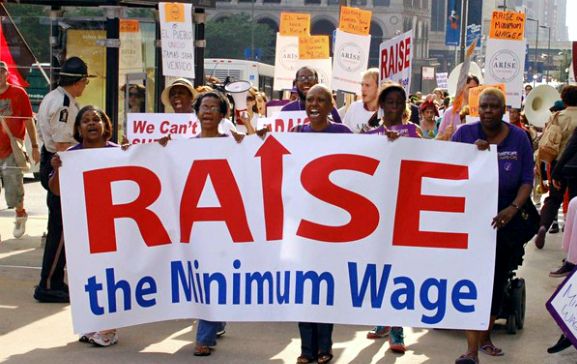State leaders, labor groups announce deal on $15 minimum wage
by Matt Fleming | March 29, 2016 8:03 am
 Democratic lawmakers and labor groups announced on Monday a deal to gradually raise the minimum wage to $15 per hour.
Democratic lawmakers and labor groups announced on Monday a deal to gradually raise the minimum wage to $15 per hour.
Gov. Jerry Brown and Senate President Pro Tempore Kevin de León of Los Angeles, joined by representatives of the Service Employees International Union and its affiliates, announced the measure to raise the minimum wage each year until 2022 and 2023, with an “off ramp” in place to slow growth in the event of an economic downturn.
“It will help our entire state do much better for its citizens,” Brown said, calling the measure a matter of “economic justice.”
However, Monday’s announcement was merely an agreement between state leaders. The measure still needs to go through the Legislature before it can become law.
Assembly Speaker Anthony Rendon, D-Paramount, who was not at Monday’s press conference, issued support in a statement afterwards and said a “significant number” of Assembly Democrats were on board.
Rendon also said he would have preferred a “more aggressive” path to $15 per hour, but said Monday’s deal was a “good middle ground.”
Things change
It wasn’t that long ago that Brown denounced[1] a $15-per-hour minimum wage. During the unveiling of his budget in January, he estimated an increase of that size would saddle the state with an extra $4 billion in costs by 2021.
But Brown and de León conceded that a much more aggressive increase had already qualified for the November ballot, so legislators are wise to embrace the more “responsible” version they negotiated with labor groups.
“This is a very pragmatic decision,” said de León. “This was not made in a vacuum — there is a ballot initiative that’s already qualified.”
The measure would increase the minimum wage 50 cents per hour in both 2017 and 2018 and then raise it $1 per hour each year until it reaches $15 per hour in 2022 for employers of 26 or more employees and 2023 for employers or 25 or less employees. Following years would be tied to inflation.
The proposal gives the governor the annual power to pause the increase due to negative economic conditions.
Good policy?
There’s still a debate among economists as to whether the nominal gains to workers of an increase in the minimum wage are actually worth the costs to businesses, which will raise prices to absorb costs and potentially cut jobs (CalWatchdog wrote[2] about this debate in greater detail earlier this year).
As it stands now, $10 per hour over a 40-hour work week comes out to $20,800 per year before taxes. With the increase of 50 cents per hour in 2017, minimum wage workers will make $21,840 per year before taxes, or around an extra $87 per month. At $15 per hour, the annual wage will be $31,200 in 2022.
The second 50 cent increase in 2018 would add $173 per month before taxes. The gains jump after two years to an increase of $1 per hour every year. The increase of $1 per hour in 2019 would come to an additional $347 per month, and so on.
However, many economists tie an increase in the minimum wage to inflation, so the gain to workers would likely not be as high as it seems now in terms of real dollars.
Lifting people out of poverty
The measure was repeatedly hailed on Monday as a strike against poverty. However, workers aren’t below the poverty line currently unless they are trying to support a family of at least four on only one minimum-wage income.
The federal poverty line is around $24,300[3] for a family of four, or $11,880 for an individual. The current minimum wage is nearly double the poverty threshold for an individual and just barely exceeds the threshold for a family of three on one minimum-wage income.
Skepticism
While the unveiling was all smiles between lawmakers and labor on Monday, the Republican leaders in both chambers were skeptical in statements that the measure would have a lasting impact on the working poor.
“Poverty reduction in California is extremely important,” said Senate Republican Leader Jean Fuller of Bakersfield. “Energy, housing and health care are cost drivers that we must address to make California more affordable. I am not sure how this new legislation moves the needle in improving California’s affordability.”
“This deal may help a small number of California’s workforce, but we are concerned that it will hurt many more by contributing to our state’s already high cost-of-living, making the California dream even less attainable for our middle class and low-income families,” said Assembly Republican Leader Chad Mayes of Yucca Valley. “We have a responsibility to build a better, more affordable state for all Californians.”
Learn more:
- Minimum wage divides experts[4]
- Years after CalWatchdog investigation, bill to end sub-minimum wage advances[5]
- denounced: http://www.bizjournals.com/sacramento/news/2016/01/08/did-brown-kill-15-dollar-minimum-wage.html
- CalWatchdog wrote: https://calwatchdog.com/2016/02/03/minimum-wage-divides-experts/
- $24,300: https://aspe.hhs.gov/poverty-guidelines
- Minimum wage divides experts: https://calwatchdog.com/2016/02/03/minimum-wage-divides-experts/
- Years after CalWatchdog investigation, bill to end sub-minimum wage advances: https://calwatchdog.com/2016/01/08/years-calwatchdog-investigation-bill-end-sub-minimum-wage-advances/
Source URL: https://calwatchdog.com/2016/03/29/state-leaders-labor-groups-announce-deal-15-minimum-wage/